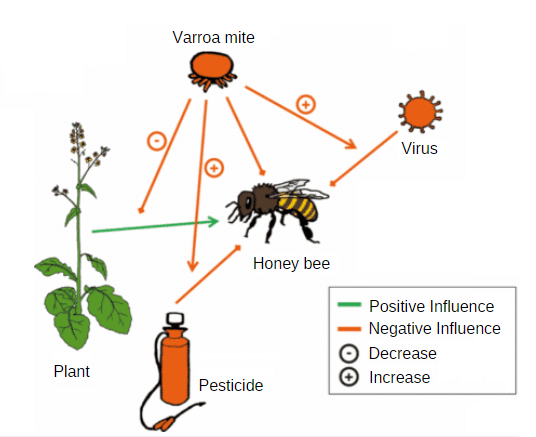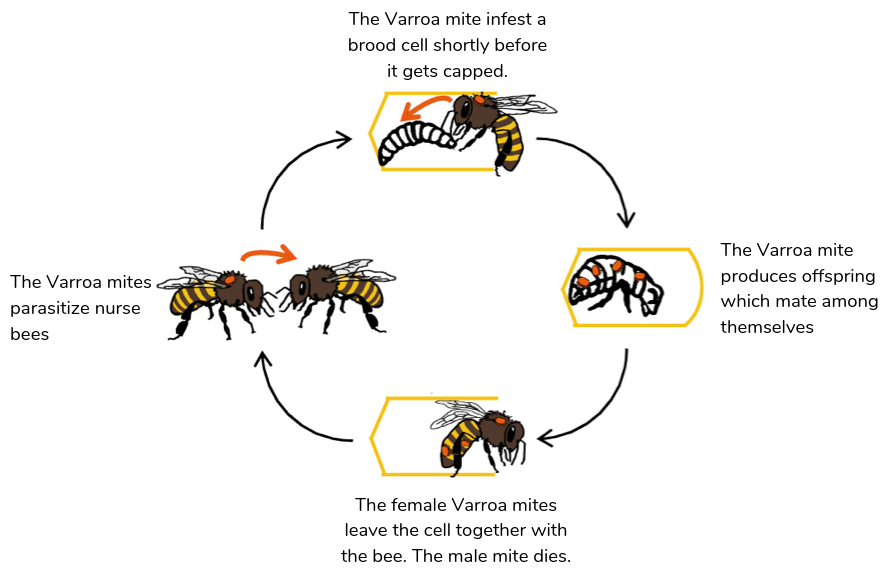We prefer not to have anything to do with them, yet the destructive rage of the Varroa destructor directly affects us beekeepers. The varroa mite is the main cause of bee mortality [1-2]. Therefore, we will take a closer look at these little beasts.
Tricky little beasts
How the Varroa mite got in contact with the European honey bee
It all started with the introduction of the European honey bee in Asia by humans. This allowed the Varroa mite to change hosts from its original host, the Asian honey bee (Apis cerana), to the European honey bee (Apis mellifera). Originating from Asia, the Varroa mite gradually spread all over the world. About only 50 years after the host change the mite had arrived in Europe in the 1970s. In the European honey bee the mite had found a much less resistant host. Which was due to the lack of co-evolution with the varroa mite. Apis mellifera had never had the opportunity to develop specific defense mechanisms. As the European and Asian honeybees are very similar in their physiology, colony organization and communication, the mite can unfortunately survive very well on the European honeybee [3].
How the Varroa mite damages the bees
The varroa mite feeds on the fat body tissue* of the bees and thus weakens them directly. Parasitized larvae develop into much smaller bees, have a lower protein content in their hemolymph (bee blood) and a much shorter life expectancy [4-5]. Affected bees fly shorter distances and show a reduced collection capacity [6-7]. In addition, the varroa mite changes the smell of the parasitized bees. This makes it difficult for the other workers to recognize them as belonging to the colony and they often become victims of aggressive behaviour, which can even lead to expulsion from their own hives [3].
As if these direct effects were not enough, the mite damages the bees also in other negative more indirect ways. Because the affected bees are smaller, they are less resistant to pesticides and other chemical agents [2]. In addition, the varroa mite suppresses the immune system of bees [8] and transmits various viruses, including the two highly pathogenic Deformed Wing Virus and Acute Bee Paralysis Virus. The Deformed Wing Virus can even multiply (replicate) within the mite, which strongly increases the parasitization by the Varroa mite [9-11]. The interaction between the mite and the viruses is considered to be the biggest threat. Without viruses a bee colony with 15000 mites can survive the winter, but if the mites are infected with viruses only 2000 mites are needed to destroy an entire colony[12] (Figure 1).

How the Varroa mite reproduces in bee colonies
The reproduction of the Varroa mite is exactly matched with the breeding behaviour and larval development of the honey bee. A mite’s life cycle begins with the invasion of a brood cell, where the mite is reproduced. The so-called mother mite will hop on a nurse bee and let herself be carried to a brood cell, which is just about to be capped. There she feeds on the maturing larva and lays eggs from which first a male and then some females will develop. The offspring will reproduce among each other and as soon as the bee hatches from the cell, the mother mite and her mated daughters will leave the cell with it. They then parasitize other nurse bees again and the reproductive cycle starts all over. The male, on the other hand, cannot survive outside the brood cell and dies [13] (Figure 2).

In order to be perfectly adapted to the lifestyle of the bees, the Varroa mite “overhears” the communication of the bees. They can recognizes various scences, which are indispensable for the organization of the bee colony. For example, from the eighth day of development, the bee larvae release a particular scent, which causes the nurse bees to cover the brood cell. Mother mites recognize this scent too and therefore know which brood cells suitable for reproduction [14-15].
In a similar way, nurse bees are recognized by their scent and can therefore be parasitized [16]. At the same time, the mites are able to imitate the specific scent of the colony they parasitize. In this way, they remain hidden from the honeybees and are optimally protected from their defence [17-18]. Nevertheless, the bees can partially remove the Varroa mites from each other and some nurse bees show Varroa-specific hygiene behaviour and will remove Varroa-infected brood [19-20]. Unfortunately, this behaviour is far too rare to be a serious threat for the mites. Therefore the honeybees are still dependent on our support!
Read more about varroa control in our next issue.
*In January 2019, a groundbreaking study was published, for decades researchers believed the varroa fed on hemolymph (bee blood), this study showed varroa actually fed on fat body tissue. Read more about this study and it’s consequences here.
Literature
1 Cornman, R. S. et al. Pathogen Webs in Collapsing Honey Bee Colonies. Plos One 7, doi:e4356210.1371/journal.pone.0043562 (2012).
2 Le Conte, Y., Ellis, M. & Ritter, W. Varroa mites and honey bee health: can Varroa explain part of the colony losses? Apidologie 41, 353-363, doi:10.1051/apido/2010017 (2010).
3 Nazzi, F. & Le Conte, Y. in Annual Review of Entomology, Vol 61 Vol. 61 Annual Review of Entomology (ed M. R. Berenbaum) 417-432 (2016).
4 De Jong, D., De Jong, P. H. & Gonçalves, L. S. Weight Loss and Other Damage to Developing Worker Honeybees from Infestation with Varroa Jacobsoni. Journal of Apicultural Research 21, 165-167 (1981).
5 Amdam, G. V., Hartfelder, K., Norberg, K., Hagen, A. & Omholt, S. W. Altered physiology in worker honey bees (Hymenoptera : Apidae) infested with the mite Varroa destructor (Acari : Varroidae): A factor in colony loss during overwintering? Journal of Economic Entomology 97, 741-747, doi:10.1603/0022-0493(2004)097[0741:apiwhb]2.0.co;2 (2004).
6 Blanken, L. J., van Langevelde, F. & van Dooremalen, C. Interaction between Varroa destructor and imidacloprid reduces flight capacity of honeybees. Proceedings of the Royal Society B-Biological Sciences 282, doi:2015173810.1098/rspb.2015.1738 (2015).
7 Kralj, J. & Fuchs, S. Parasitic Varroa destructor mites influence flight duration and homing ability of infested Apis mellifera foragers. Apidologie 37, 577-587, doi:10.1051/apido:2006040 (2006).
8 Yang, X. L. & Cox-Foster, D. L. Impact of an ectoparasite on the immunity and pathology of an invertebrate: Evidence for host immunosuppression and viral amplification. Proceedings of the National Academy of Sciences of the United States of America 102, 7470-7475, doi:10.1073/pnas.0501860102 (2005).
9 Gisder, S., Aumeier, P. & Genersch, E. Deformed wing virus: replication and viral load in mites (Varroa destructor). Journal of General Virology 90, 463-467, doi:10.1099/vir.0.005579-0 (2009).
10 Bowen-Walker, P. L., Martin, S. J. & Gunn, A. The transmission of deformed wing virus between honeybees (Apis mellifera L.) by the ectoparasitic mite Varroa jacobsoni Oud. Journal of Invertebrate Pathology 73, 101-106, doi:10.1006/jipa.1998.4807 (1999).
11 Shen, M. Q., Yang, X. L., Cox-Foster, D. & Cui, L. W. The role of varroa mites in infections of Kashmir bee virus (KBV) and deformed wing virus (DWV) in honey bees. Virology 342, 141-149, doi:10.1016/j.virol.2005.07.012 (2005).
12 Carreck, N. L., Bell, B. V. & Martin, S. J. Honey bee colony collapse and changes in viral prevalence associated with Varroa destructor. Journal of Apicultural Research 49, 93-94, doi:10.3896/ibra.1.49.1.13 (2010).
13 Rosenkranz, P., Aumeier, P. & Ziegelmann, B. Biology and control of Varroa destructor. Journal of Invertebrate Pathology 103, S96-S119, doi:10.1016/j.jip.2009.07.016 (2010).
14 Trouiller, J., Arnold, G., Chappe, B., Le Conte, Y. & Masson, C. Semiochemical basis of infestation of honey-bee brood by varroa jacobsoni Journal of Chemical Ecology 18, 2041-2053, doi:10.1007/bf00981926 (1992).
15 Rickli, M., Guerin, P. M. & Diehl, P. A. Palmitic acid released from honeybee worker larvae attracts the parasitic mite Varroa jacobsoni on a servosphere. Naturwissenschaften 79, 320-322, doi:10.1007/bf01138711 (1992).
16 Pernal, S. F. et al. Semiochemicals influencing the host-finding behaviour of Varroa destructor. Experimental and Applied Acarology 37, 1-26, doi:10.1007/s10493-005-1117-x (2005).
17 Kather, R., Drijfhout, F. P. & Martin, S. J. Evidence for colony-specific differences in chemical mimicry in the parasitic mite Varroa destructor. Chemoecology 25, 215-222, doi:10.1007/s00049-015-0191-8 (2015).
18 Kather, R., Drijfhout, F. P., Shemilt, S. & Martin, S. J. Evidence for Passive Chemical Camouflage in the Parasitic Mite Varroa destructor. Journal of Chemical Ecology 41, 178-186, doi:10.1007/s10886-015-0548-z (2015).
19 Boecking, O. & Spivak, M. Behavioral defenses of honey bees against Varroa jacobsoni Oud. Apidologie 30, 141-158, doi:10.1051/apido:19990205 (1999).
20 Spivak, M. Honey bee hygienic behavior and defense against Varroa jacobsoni. Apidologie 27, 245-260, doi:10.1051/apido:19960407 (1996).